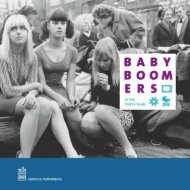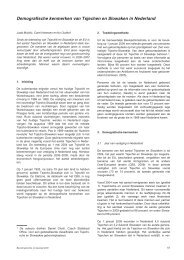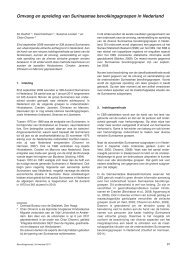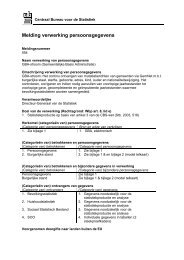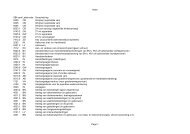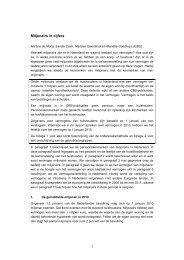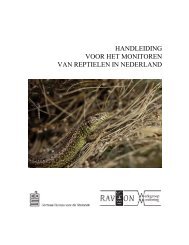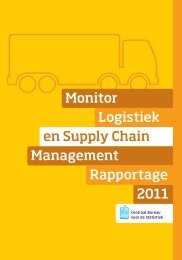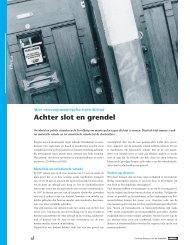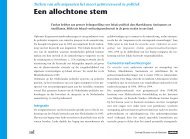Methoden voor de berekening van de emissies door mobiele ... - CBS
Methoden voor de berekening van de emissies door mobiele ... - CBS
Methoden voor de berekening van de emissies door mobiele ... - CBS
Create successful ePaper yourself
Turn your PDF publications into a flip-book with our unique Google optimized e-Paper software.
changed in the Netherlands in 1999 [ref 64: Machrafi and Mertens, 1999] it was <strong>de</strong>ci<strong>de</strong>d to implement the<br />
changes based on analyses in Belgium [ref 63: FAPETRO, 2000] in the expectation of the research in the<br />
Netherlands, which hopefully will be conducted in the near future. According to European legislation,<br />
every Member State must report on fuel quality during the previous year on June the 30 th of every<br />
year. The Dutch monitoring results are published on the EU-website. Table 1D below shows the<br />
emission profiles for the statistical year 1999 and before, and for the statistical year 2000 and<br />
afterwards.<br />
Table 1D Emission profile for the emission of benzene (percentage by weight)<br />
Petrol Petrol vapour<br />
1999 and 2000 and<br />
1999 and 2000 and<br />
before later<br />
before later<br />
Benzene 1) 2.5 0.8 1 0.3<br />
Toluene 15 12.5 3 2.5<br />
Xylene - - 0.5 0.5<br />
Aliphatic hydrocarbons (non-halogenated) 35 60 95 97<br />
Aromatic hydrocarbons (non-halogenated) 65 40 5 3<br />
1)<br />
A factor of 1.2 was used to convert the volume percentage of benzene to the weight percentage.<br />
1.7.3 Particulate matter emission (non-combustion)<br />
1.7.3 Particulate matter emission<br />
Heavy metal emissions from wear of tyres, brakes and the road surface<br />
The heavy metal composition of particulate matter emission due to wear is shown in Table 1.29B. The<br />
data in this table concerning brake wear originate from the fact sheet "emissions from brake linings"<br />
[ref 107: RWS-Waterdienst].<br />
1.8 Regionalization<br />
Regarding the vehicle kilometres travelled outsi<strong>de</strong> the urban area, regionalization of data is based on<br />
traffic intensities. Emissions within the urban area are allocated based on the number of resi<strong>de</strong>nts.<br />
Road traffic<br />
combustion,<br />
tyre wear,<br />
evaporation,<br />
leakage of<br />
motor oil<br />
Allocation parameter<br />
1. motorways (national trunk roads): vehicle km per<br />
road section<br />
2. provincial roads: vehicle km per road section<br />
3. within the urban area: population <strong>de</strong>nsity<br />
(500*500m)<br />
37<br />
Update frequency<br />
Every three years, most<br />
recently in 2006 (data<br />
for 2004)<br />
The locations and lengths of the road sections originate from the Nationaal Wegen Bestand 14 (NWB)<br />
that is managed by the DG for Public Works and Water Management-DVS.<br />
The intensities on motorways have been calculated on the basis of DVS traffic counts.<br />
For the traffic intensities on the provincial roads and in urban areas the information originates from the<br />
‘New Regional Mo<strong>de</strong>l’ (NRM), which is un<strong>de</strong>r supervision of DVS. Besi<strong>de</strong>s traffic counts this mo<strong>de</strong>l<br />
also uses social economic and <strong>de</strong>mographic factors as population <strong>de</strong>nsity and composition, existing<br />
employment and type of businesses in the vicinity. In case of intensities within urban urban area, data<br />
has been used originating from municipal environmental traffic maps. The results of the NRM (New<br />
regional mo<strong>de</strong>l) originate from PBL/LOK (Local environment team of the Netherlands Environmental<br />
Assessment Agency), where they are used as input for noise calculations. Various documents about<br />
the spatial allocation of emissions can be found on the Emission Registration site.<br />
14 National Road Database



